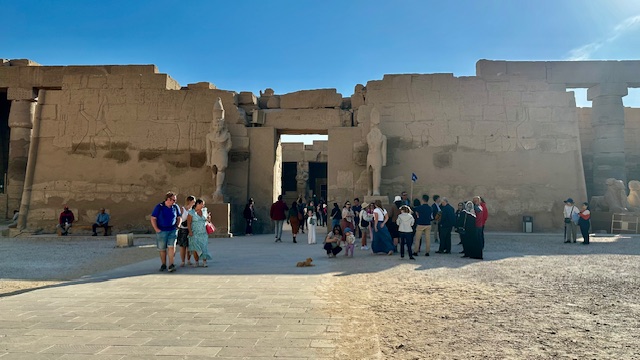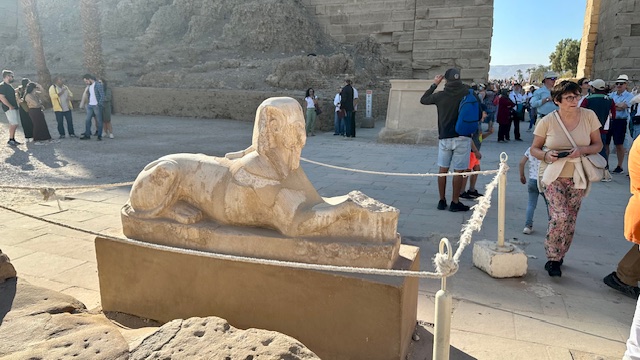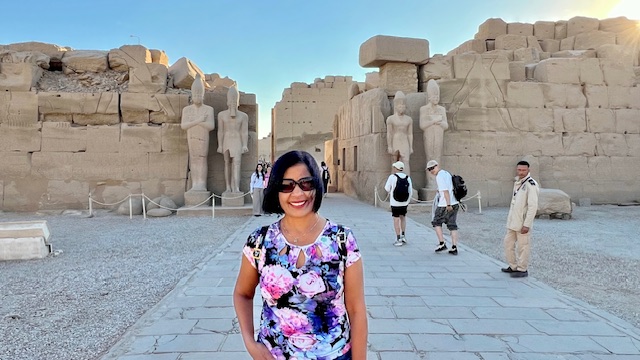- Ride around Luxor town on horse carriage
- Karnak Temple
- Luxor Temple
In the morning, we visited sites on Luxor’s East bank starting with a ride around the town on a horse carriage. We stopped on the way to have a drink of sugar cane juice and then went on to the market place and did some shopping and bargaining.





We then checked into our cruise ship that was docked on river Nile, and had lunch on the ship. The ship had a spacious deck where we spent most of our time relaxing and enjoying the calm waters.



We began our afternoon tour with a visit to the huge Karnak temple. The temple was built during the reign of Middle Kingdom to worship the sun god Amun-Ra. It spans about 200 acres and successive pharaohs kept adding/updating the temple over period of 1500 years. New Kigdom pharaohs like Hatshepsut, Thutmose III, Seti I, and Ramses II also made significant contributions to the complex during their reign.
Most of the history is recorded on the walls of the temple which provides clues about ancient Egyptian religion as well as war information like who won the war, territories gained etc. The mammoth temple has multiple temples, precincts, courtyards, halls, and pylons. If you are short on time, the temple of Amun is the main and biggest temple in Karnak and must be seen.
Your first view of Karnak is from the avenue of ram-headed sphinxes that sit in front of the massive first pylon or gateway.


As you enter the first courtyard, Temple of Seti II is on the left and Temple of Ramses III is on the right. There is a Sphinx in the center that is thought to have features of Tutankhamun.



The courtyard also has the huge kiosk of Tahraqa. Of its original 10 columns, only one on the right survived complete with its open capital and abacus; five on the left have been reconstructed. There are also colonnades with ram-headed sphinxes on either side of the courtyard. The sphinxes represent the power of pharaohs.


Once you cross the first courtyard and through the second pylon, you will be in the famous Great Hypostyle Hall which should be considered one of the wonders of the world. There are more than 130 colossal columns surging into the sky and you will want to spend all your time here. The walls of the hall, and the shafts/abaci of the columns are covered with inscriptions and reliefs of pharaohs making offerings, many of which have preserved their original coloring.


Obelisk Court in Karnak Temple

Once you cross the Hypostyle hall and beyond the Third pylon you will be in the courtyard with Obelisks of Tuthmosis I and Hatshepsut. Of the 17 obelisks that were present in Karnak temple, only these 2 stand intact. A broken obelisk of Hatshepsut is on display near the sacred Lake.

Other sites in the temple complex include the sacred lake, the top section of the broken Hatshepsut’s obelisk, Festival Hall of Tuthmosis III, and Temple of Amenophis.




It will take one a few days to a week to see every precinct in this temple. We explored as much as possible in the 2 hours we were there.
Luxor temple – It was late afternoon by the time we reached this temple. Smaller than Karnak, this temple was built in 1400 BC, mostly by Amenhotep III and Ramesses II. Additions were made by outside conquerors like Alexander the great. The temple is dedicated to Amun, his wife Mut and their son the moon god Khons or Khonsu.
The Avenue of Sphinxes – Also known as the King’s festival road, it is 2.7km long connecting Karnak with Luxor temple. Ram-headed statues line up on both sides of the avenue leading up to Luxor temple. Each year Egyptians celebrate Opet Festival during which a ceremonial boat is used to transport the gods along the avenue of sphinxes from Karnak to Luxor temple.

At the entrance to the Luxor temple stands the monumental pylon built by Ramses II which displays war scenes of Ramses II against Hittites. In front of the pylon there were formerly 2 obelisks of Ramses II, of which only 1 remain, because the other was transported to Paris in 1833 and resides in the center of Place de la Concorde. Two huge statues of pharaoh sit on the throne in front of the pylon.

From the first pylon, you enter the Court of Ramesses II. You can also see the Mosque of Abu al-Haggag from here. This mosque was built in this complex after the spread of Islam.


The Court of Ramses II is surrounded with more than 70 papyrus columns. You can see statues of Ramses II and Osiris statues between some of the columns here.


You then walk through the enormous colonnade of papyrus columns – 2 rows of columns with 7 columns in each row. This walkway leads to the Sun court of Amenhotep III. The sun court was used for the ritual of royal jubilee, a celebration of king’s rule.


Beyond this are antechambers. One of these was converted into a church by the Romans in the 4th century AD. The walls were plastered and painted with Christian paintings. The romans also used the temple as a fort. The roman emperor’s throne was here.

We ended the day with dinner on the cruise ship.